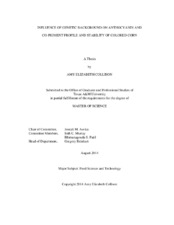| dc.description.abstract | Growing consumer demand for healthy and natural snacks provides an opportunity for utilization of pigmented corn in the tortilla chip market. This study determined the effect of phenotype^(1) on anthocyanin and co-pigment composition and processing stability of several experimental hybrid varieties of corn from four phenotypes (red, purple, blue, and red/blue). The goal was to determine if genetics/phenotype can be utilized to selectively breed for pigmented corn lines with greater stability during thermo-alkaline processing. The pigment and co-pigment composition were determined using LC-MS/MS. Total and monomeric anthocyanin contents were quantified using pH differential method. Effect of thermo-alkaline processing on anthocyanin profile and color stability was measured using the aforementioned methods, as well as with a colorimeter.
The blue and red/blue phenotypes had similar pigment profiles with the more stable acylated anthocyanin cyanidin-3-(6”-malonylglucoside) present in greatest proportion and as such were hypothesized to have greater stability during processing. The purple phenotype contained a higher proportion of monomeric cyanidin-3-glucoside. Generally, anthocyanin profile was similar within phenotype. Regarding total anthocyanin content, the purple phenotype had the highest level of anthocyanins (890-3312 μg/g), and the red phenotype had the lowest (8.9-127 μg/g). For non-purple samples, a clear effect of environment on anthocyanin content was observed, with samples grown in Weslaco, TX having consistently higher levels than samples grown in College Station, TX. This suggests specific environments may favor better accumulation of the anthocyanins.
During processing of corn into tortilla chips, the purple sample underwent the most significant change in anthocyanin content, retaining 59.1% and 32.1%, at 0.5% and 1% lime treatment levels, respectively. The blue and red/blue samples retained 88.0% and 78.6% (0.5% lime level), respectively, and 63.6% and 51.2% (1% lime level), respectively. However, chroma properties of the blue sample decreased unfavorably during processing.
Overall, the red/blue sample performed best at the alkaline pH encountered in tortilla chip processing, with good pigment retention, high lightness value (38.6) and relatively high chroma (9.3) at the 1% lime level, indicating that anthocyanin profile may predict color stability during processing. Therefore, these phenotypes could be improved for use in commercial tortilla chip processing. | en |


